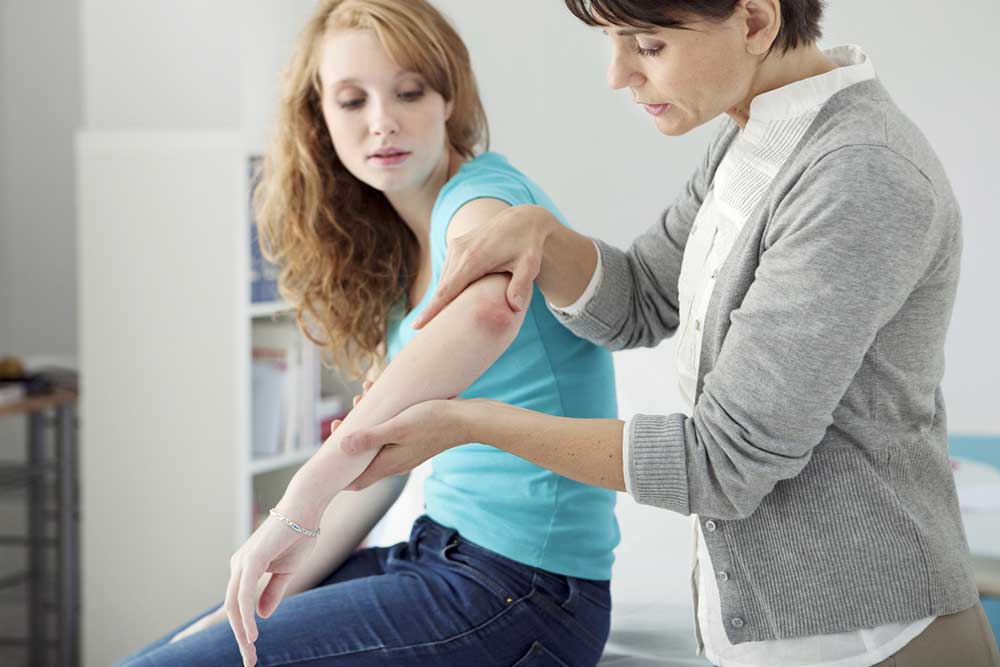Types and Treatments of Plaque Psoriasis

Psoriasis is a skin condition that accelerates the life cycle of skin cells. It causes skin cells to form rapidly on the surface of the skin. The extra skin cells formed on the surface can be itchy and painful. Psoriasis is a chronic disease and the main goal of treating it is to inhibit the fast growth of skin cells. Plaque psoriasis is one of the most common forms of psoriasis as it can cause dry, raised, red skin lesions covered with silvery scales (plaques).
Psoriasis patches range from a few spots with a dandruff-like scaling to major eruptions that cover a large area. Plaque psoriasis goes through cycles wherein it can have flaring symptoms lasting for a few weeks or months, then subsiding for some time, going into complete remission.
Here are other manifestations of plaque psoriasis based on the nature of symptoms:
- Nail psoriasis
It affects the toenails, fingernails causing pitting, discoloration, and abnormal nail growth. As a result, this type of psoriasis can loosen up the nail, separating it from the nail bed. Severe cases of nail psoriasis might also cause the nail to crumble. - Guttate psoriasis
It primarily affects young adults and children and is usually triggered due to bacterial infection such as strep throat. Guttate psoriasis is usually distinguished by small, drop-shaped scaling lesions on the torso, arms, legs, and scalp. - Inverse psoriasis
It mainly affects the skin near armpits, groin, and under the breasts. Inverse psoriasis results in smooth patches of red inflamed skin which worsens with friction and sweating. This type of plaque psoriasis could be a result of fungal infection. - Pustular psoriasis
It is an uncommon form of psoriasis and has widespread patches on hands, feet or fingertips. - Erythrodermic psoriasis
Another least common type of psoriasis, it can cover the entire body with red peeling rash that itches and burns intensely. - Psoriatic arthritis
With inflamed and scaly skin, this type of psoriasis can also cause painful and swollen joints. The symptoms range from mild to severe scaly patches that usually affect the knees and elbows. Although psoriatic arthritis is not as crippling as rheumatoid arthritis, it can still cause progressive joint damage leading to permanent deformity.
Treatments
The main aim to treat psoriasis is to reduce inflammation and clear the skin. The treatment is divided into the following three main types:
Topical treatments
The treatment can be in the form of ointments and creams that can be applied to the skin for treating mild to moderate psoriasis. In severe cases, the topical treatments are likely to be combined with other forms of medications or light therapy. Treating topical psoriasis includes:
- Topical corticosteroids
Topical medications like corticosteroids help in reducing inflammation and relieve itching. Corticosteroids can be used with other treatments for more severe cases. Mild corticosteroids are recommended to areas such as skin folds and the face and are also used to treat widespread patches of damaged skin. Stronger corticosteroids might be prescribed for smaller and less sensitive or tougher areas. Doctors suggest using topical corticosteroids as a short-term treatment, as using them for longer periods might stop providing relief. - Anthralin
The medication helps in slowing skin cell growth. It does so by getting rid of scales formed due to plaque psoriasis, making the skin smoother. One must be aware that some forms of anthralin can irritate and stain the area of application. - Salicylic acid
Available as an over-the-counter medication, salicylic acid promotes the sloughing of dead skin to reduce scaling. It can be combined with other medications too such as topical corticosteroids and coal tar to increase the effectiveness. Salicylic acid can be used in the form of shampoos available to treat scalp psoriasis.
Light therapy
The therapy uses natural or artificial ultraviolet light. Light therapy is the simplest form of treatments which involves the exposure of skin to a controlled amount of sunlight. Following are some of the therapies that use light to treat the symptoms of plaque psoriasis:
- UVB phototherapy
UVB light therapy involves the use of narrowband ultraviolet B. The plaque-psoriasis-affected skin is exposed to ultraviolet B light for two to three times a week until the skin condition improves. Short-term side effects include temporary redness, itching, and dry skin. It is recommended to use a moisturizer to decrease the side effects. - Goeckerman therapy
Some doctors combine two different therapies for effective results. Goeckerman therapy uses UVB treatment and coal tar treatment applying coal tar to the affected area making it more responsive to UVB therapy. - Excimer laser
This type of therapy treats mild to moderate plaque-psoriasis symptoms. Excimer laser therapy uses a concentrated beam of UVB which is directed on skin affected with scales and inflammation. It requires fewer sessions when compared with UVB phototherapy and the side effects include redness and blistering.
Injected or oral medications
This type of therapy is used for severe cases of plaque-psoriasis. The doctors might prescribe medications such as retinoids, methotrexate, and cyclosporine to suppress the immune system of the body. This slows down the skin life cycle and helps in relieving from plaque-psoriasis symptoms. However, doctors prescribe these medications on a short-term basis as the suppressed immune system can make the body vulnerable to other infections.